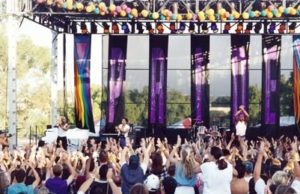1995
 By the mid-1990s, homosexuality was beginning to gain acceptance by the mainstream media and through that, acceptance by viewing audiences. Television shows like “The Real World San Francisco,” “Friends,” and “My So Called Life,” exposed many audiences to three-dimensional gay and lesbian characters for the first time. In addition, big-name celebrities began to come out of the closet, all of which would have the effect of challenging people’s stereotypes and opinions of homosexuality.
By the mid-1990s, homosexuality was beginning to gain acceptance by the mainstream media and through that, acceptance by viewing audiences. Television shows like “The Real World San Francisco,” “Friends,” and “My So Called Life,” exposed many audiences to three-dimensional gay and lesbian characters for the first time. In addition, big-name celebrities began to come out of the closet, all of which would have the effect of challenging people’s stereotypes and opinions of homosexuality.
Homosexuality began to be welcomed into mainstream and bisexuality began to creep into people’s vocabulary. As different sexualities became more accepted by society, Pride also became more accepted by the mainstream community. This enabled organizers to recruit big names for the parade and festival. It also helped attract larger crowds, both gay and straight, to the events as the stigma surrounding it began to fade. These factors helped Pride continue to generate an increasing amount of money for the community.
Tijuana Pride
While gays and lesbians in the U.S. were experiencing a renaissance in mainstream attitudes towards homosexuality, our neighbors to the south in Tijuana were just beginning to organize. On Saturday, June 17th, Tijuana’s first Pride march started at the intersection of Avenida Constitutión and 2nd Street and proceeded to march south on Avenida Revolución. The march was organized by Grupo Y Que, with the help of activists on both sides of the border.
Only 85 people marched in that first parade, and many of them were supporters from this side of the border. Local activists Francheska and Nicole Murray-Ramirez were among those who led the march. Grupo Y Que faced an uphill struggle in gaining the support of the community and, in that first march, even the city’s gay bars declined to join the march for fear of reprisals from the authorities. In the end, the march was a success and was the beginning of many Tijuana Prides to come. That July, Grupo Y Que marched in San Diego’s Pride parade to thank San Diegans for their support.
Olympic Star Power
The biggest attraction at San Diego Lesbian and Gay Pride in 1995 was Olympic diving gold-medalist Greg Louganis. Louganis grew up in San Diego and gained international fame when he won gold medals in the 1984 and 1988 Olympics. Louganis had come out of the closet the previous year and, in 1995, he had just written his autobiography, Breaking the Surface. The book described his life story as a closeted gay athlete and revealed that he was HIV-positive.
Louganis was the parade Grand Marshal and a speaker at the rally, and signed autographs at the Pets Are Wonderful Support organization’s booth. The presence of a big name, especially one who had local roots, helped attendance of the three events to top 60,000 people. It also helped Pride parlay the media coverage of Louganis into a more positive coverage of Pride from the non-gay media outlets.
Sponsors Get on Board
One of the most subtle reflections of the heterosexual community’s changing attitudes towards San Diego Pride was in the area of sponsorships and participation by local and national companies. While early Pride organizers struggled to get even gay-owned and gay-friendly businesses to participate in the marches, by 1995 both local and national mainstream businesses were eager to come to the table. As the stigma surrounding homosexuality began to recede, businesses began to realize that gays and lesbians were a largely untapped market with disposable incomes.
By 1995, the Pride program boasted many big-name local and national advertisers. Local businesses like radio stations 92.5 “the Flash,” Jammin’ Z90 and Mesa Distributing Company had a presence at Pride. National companies also reached out to our community, including American Airlines, Naya bottled water, and Anheuser-Busch.
One source of revenue that the Board chose not to pursue was tobacco money. Although some members of the Board smoked themselves, they turned down ads from a potentially lucrative source of income.
The Board also made a conscious decision not to accept ads which were sexually explicit in nature or which objectified the human body. They were willing to turn away advertisements, if necessary. Larry Baza recalls one ad in particular which Pride refused to put in the program unless modifications were made; they figured that they were going to lose the ad, but the advertiser was willing to make the changes in order to get in the program.